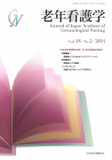Japanese
English
- 販売していません
- Abstract 文献概要
- 参考文献 Reference
抄録
本研究の目的は,在宅虚弱高齢者である二次予防事業参加者の疼痛有症率と疼痛の状況が健康関連QOLに及ぼす影響について明らかにすることである.対象者は495人,平均年齢は,84.7(±5.4)歳であった. 過去1か月間の疼痛有症率は73.1%,もっとも多い疼痛部位は腰部,疼痛部位数の平均数は1.9(±1.0)か所であった.SF-8は,PCS(身体的QOLサマリースコア)が非疼痛有症群52.1(±4.0)点,疼痛有症群44.3(±5.7)点で有意に疼痛有症群が低く,MCS(精神的QOLサマリースコア)は,非疼痛有症群51.0(±5.7)点,疼痛有症群51.9(±6.2)点で有意な差はみられなかった.疼痛有症群におけるSF-8のPCSとMCSを目的変数として重回帰分析を行った結果,PCSを抑制するものは,もっとも強い疼痛の程度,疼痛による歩行能力への支障,疼痛による対人関係への支障,神経障害性疼痛スクリーニング得点,疼痛による生活を楽しむことへの支障であった.MCSを有意に抑制するものは,疼痛による気分・情緒への支障と疼痛による対人関係への支障であった.
The aims of this study were to reveal pain prevalence and the situation of pain which affects health- related QOL among community-dwelling frail elderly in the Long-Term Care Prevention Project for persons at risk of being in need of support. The subjects were 495 elderly people, with an average age of 84.7(±5.4). The pain prevalence of the past month was 73.1% in this study and the most usual location of pain was the lower back, with the average pain locations being 1.9(±1.0). In the SF-8 PCS (Physical component summary) with the pain group 44.3(±5.7) was significantly lower in the no pain group 52.1(±4.0). In the SF-8 MCS (Mental component summary) there was no significant difference between the pain group 51.9(±6.2) and the no pain group 51.0(±5.7). Multiple regression analysis was performed using the SF-8 PCS and the SF-8 MCS in the pain group as dependent variables. The factors of SF-8 which controlled the PCS were: the worst pain intensity; when the pain has interfered with your walking ability; the pain interfered with relations with other people; the neuropathic pain screening score; and the pain interfered with enjoyment of life. The factors of SF-8 which controlled the MCS were pain which interfered with mood and the pain which interfered with relations with other people.
Copyright © 2014, Japan Academy of Gerontological Nursing All rights reserved.


